10 Reasons Why Boston Is the Best Running City in America
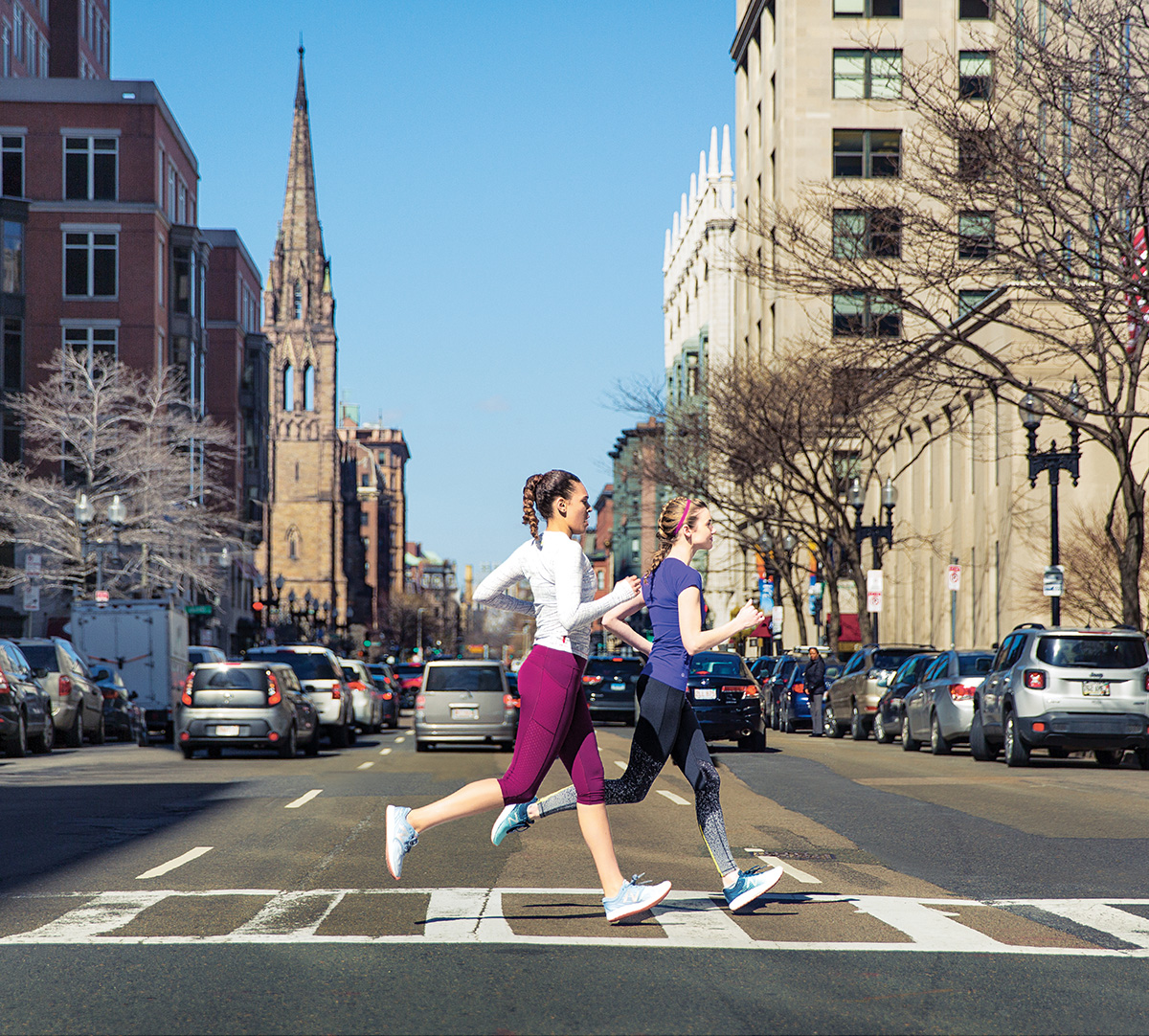
Photograph by Trevor Reid / Styling by Abby Bielagus, hair and makeup by Yojanse Jimenez/Team, Models: Kate Novak/Maggie Inc. and Kacey Gill/Maggie Inc.
Because
1. We Train with the Best

Courtesy Photos
Where there are good runners, there are great coaches. Whether you’re prepping for the marathon or just a sprint around the neighborhood, you’d do well to heed the wisdom of these top trainers.
- Celebrate incremental success. | “If your end goal is to run that full mile, then running for five minutes might be your first goal. Setting those small goals within that bigger one is really important, and creates more positivity.” —Katie Dolaher, private running coach and seven-time Boston Marathoner
- Schedule everything. | “Planning ahead is the thing that ties together all my different training philosophies—when you’re going to run, who you’re going to run with, how you’re going to refuel afterward, and making sure you’re getting enough sleep. As long as you’re thinking about all of that ahead of time, you can’t lose.” —Paige Kouba, Saucony-sponsored runner and assistant coach for Harvard women’s cross-country
- Cross-train—within reason. | “I do think there’s a benefit to working different muscles. If you’re doing cross-training that’s making you feel good and it’s benefitting you, that’s good. But I have worked with some people that, when they don’t run, they go cycling for 40 miles and then go to the gym for an hour. Are you really getting rest?” —Dan Smith, running coach and former Boston Athletic Association runner
- Allow time to recover. | “If you want to do 10 miles and then shower and hop in the car, I’d recommend you instead do 8 miles and then spend 15 minutes taking care of yourself—sitting down and stretching, foam rolling, or being able to take a good shower. That’s how you get injured, if you don’t take care of yourself after a run.” —Mark Coogan, former Olympic marathoner and Team New Balance coach
Because
2. We’re a City of Champions
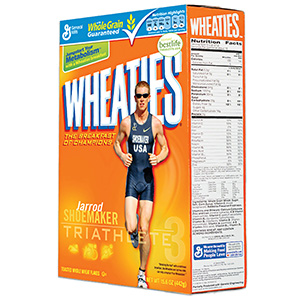
Photograph by Toan Trinh
Way back in 1896, a Bostonian named Arthur Blake repped his city in the first modern Olympic Games, traveling to Athens to run the 1,500 meters and the marathon. Ever since, this tiny state has been churning out more than its fair share of talent, from the track to the triathlon.
- Abbey D’Agostino | The world fell in love with this 24-year-old Topsfield native during the 2016 Rio Olympics, when, during a 5,000-meter heat, she collided with another runner and tumbled to the ground. Despite suffering from a torn ACL, D’Agostino helped her competitor up and finished the race.
- Shalane Flanagan | Marblehead’s own has competed in four Olympics, taking home the bronze in 2008 for the women’s 10,000 meters. She’s also a regular presence at the Boston Marathon, where she ran the fastest-ever time by an American woman in 2014.
- Alberto Salazar | The Cuban-born Salazar’s laundry list of achievements includes a 1984 Olympic bid, New York City and Boston marathon victories, and American records in the 5,000 and 10,000 meters. The Wayland High alum is also in the National Distance Running Hall of Fame.
- Jarrod Shoemaker | You may not know the name, but you surely remember the face. This Sudbury son ran his way onto the Wheaties box (pictured) ahead of the 2008 Beijing Olympics, an honor he secured by becoming the first man to make the U.S. triathlon team. (He ended up finishing 18th.)
Because
3. We Make the World’s Running Shoes
To grasp Boston’s dominance in the footwear industry, all you have to do is drive into the city.
Off the Mass. Pike, you’ll find New Balance’s futuristic Brighton headquarters. Visible from I-93, there’s Converse’s old-meets-new Lovejoy Wharf building. Saucony’s Waltham home base is within spitting distance of I-95. The city is virtually surrounded.
To understand why Greater Boston has become a global sneaker hub, you have to look to the past: specifically, to the mills and factories that once dotted the region. “There’s been a long history of New England being a manufacturing hub in materials that lend itself to the shoe business,” explains former footwear exec and Boston University marketing lecturer Patricia Hambrick. These days, most production has been outsourced, but heritage brands and scrappy startups alike continue to set up shop around here. “That combination of history, sports culture, and employee base,” Hambrick says, “makes it a really great place to be.”
Need evidence? The proof’s in the (local) kicks.
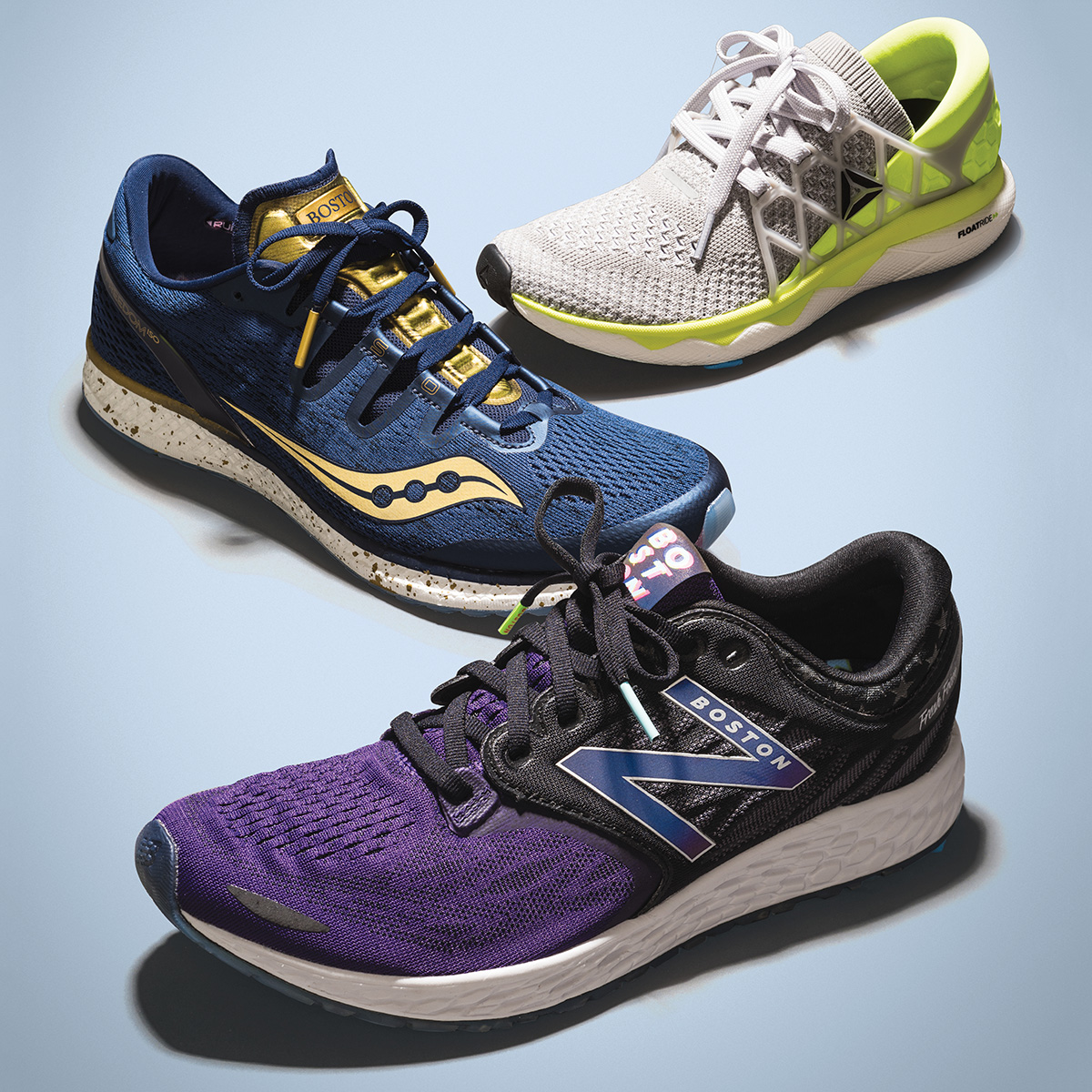
Photograph by Emily Sotomayor
From top:
- Reebok “Floatride” | These April releases boast breathable, cushioned comfort and eye-catching color palettes. $150, reebok.com.
- Saucony “Freedom ISO Boston Marathon Edition” | Celebrate the world’s best marathon with gold-flecked soles and metallic detailing. $160, saucony.com.
- New Balance “Limited Edition Fresh Foam Zante V3 Boston” | Each year, New Balance creates a shoe honoring its hometown. This year’s is designed for the most efficient foot strike possible. $115, newbalance.com.
Because
4. The Cold and Snow Make Us Stronger
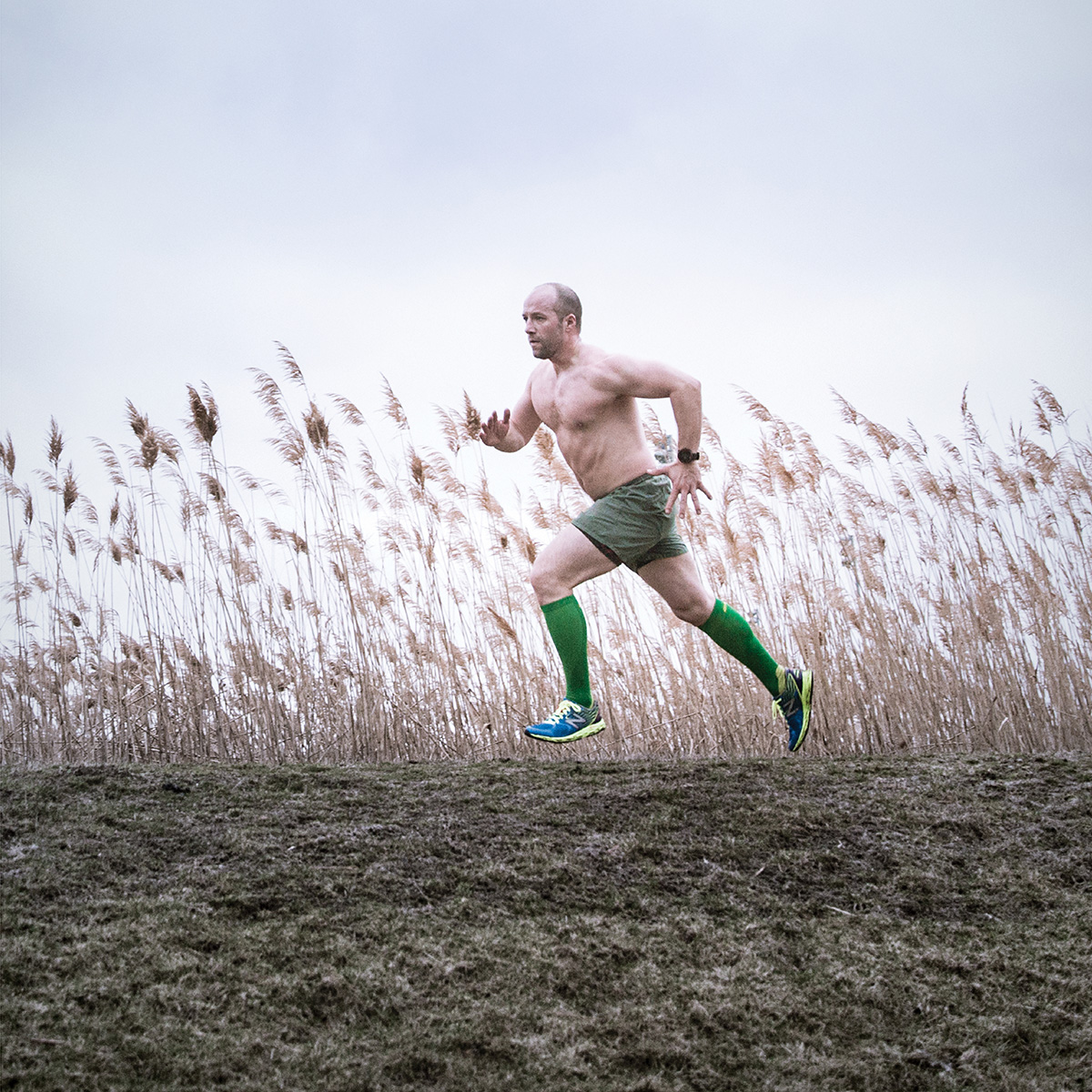
Photograph by Trevor Reid
If the temperature tops 30, Malcolm Purinton runs outside—shirtless. He’s out when it’s colder, too, just with a little more clothing. “The worse the weather,” he says, “the better the story.”
Purinton, a devotee of the all-weather fitness tribe November Project, may take it to the extreme, but his behavior is by no means unique. This is a city of cold-weather, crack-of-dawn, rain-or-shine runners. New Balance even pays to keep trails along the Charles River snow-free in the winter months—a must for marathon trainers.
Are the people who use them devoted? Certainly. Are they crazy? Maybe a little bit. But more than anything, they’re ambassadors of a city that prides itself on grit and heart.
“You’re sharing the experience, whether you were actually with someone or not,” Purinton says of his brutal workouts. “You have this common ground with every runner in the city.”
Because
5. We Run for Good
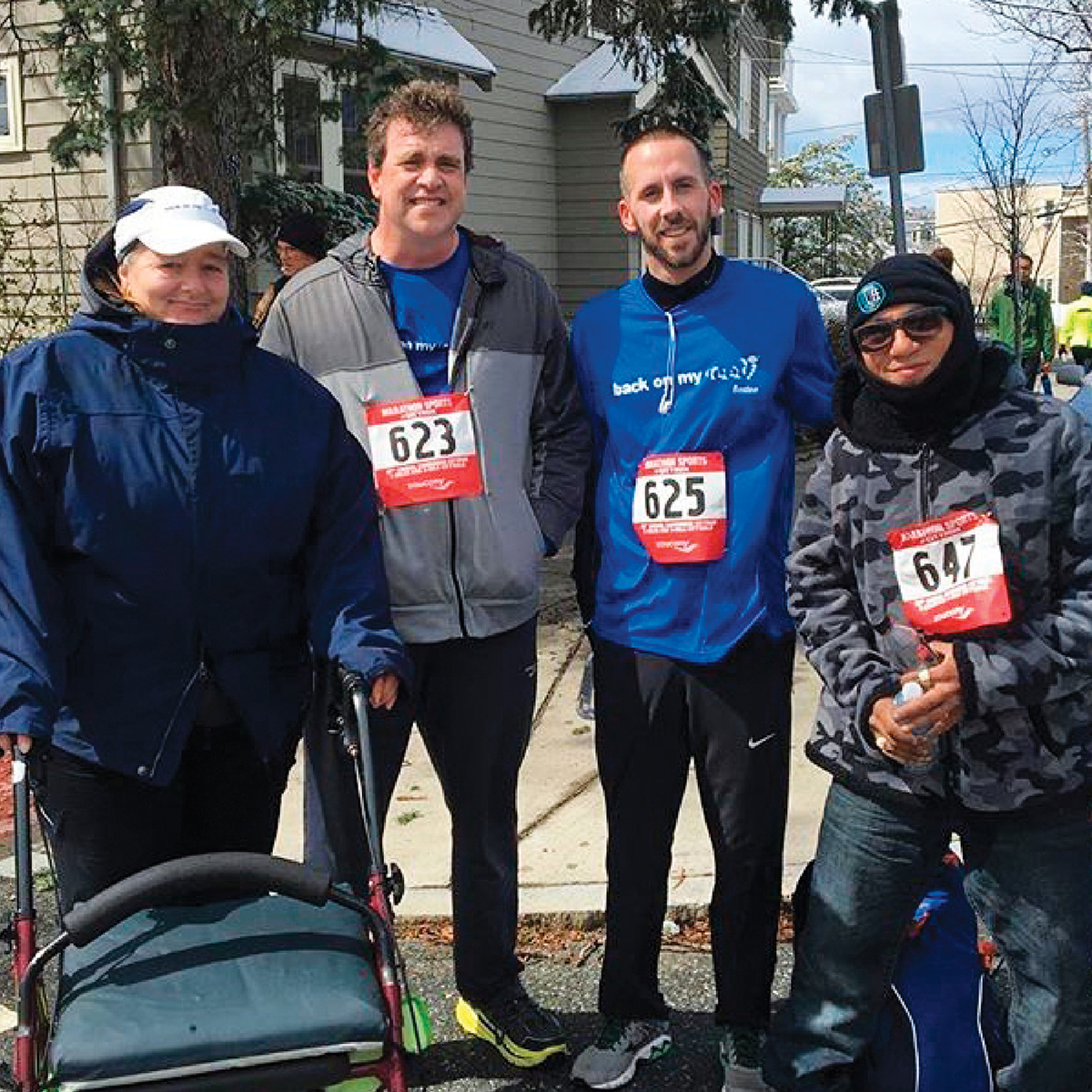
Courtesy Photo
Substance abuse had taken its toll on Kurt Ronan. In 2010, after years of addiction and sporadic homelessness, he found himself living in a Boston halfway house. That’s where he heard about Back on My Feet (BOMF), a charity that offers professional guidance, educational support, and housing assistance to those in danger of homelessness. The catch? He’d have to pound pavement first.
The philosophy behind BOMF is simple: Help people develop life skills such as perseverance and inward motivation through the simple act of running. Like other participants, Ronan woke up three mornings a week at 5:45 to jog with the group before moving into the Next Steps program, where advisers helped him find stable housing. “It taught me discipline,” Ronan says. “Just get out there and run, put one foot in front of the other.”
Of course, the local chapter of the nonprofit isn’t the only running-focused group doing good around town. From marathon competitors, who last year raised a collective $30.6 million for assorted charities, to Newton Athletes Unlimited, which sponsors track and field and other sports programs for those with disabilities, Bostonians are dedicated to improving the lives of others—and burning calories in the process.
These days, Ronan (pictured third from left) lives in an apartment with his girlfriend and their infant child and works in facilities at a private equity firm. None of it, he says, would have been possible without BOMF. “Before, I was living at rooming houses and in the backseats of cars,” he says. “I honestly feel like without the help of Back on My Feet, I’d still be there.”
Because
6. Our Trails Rock
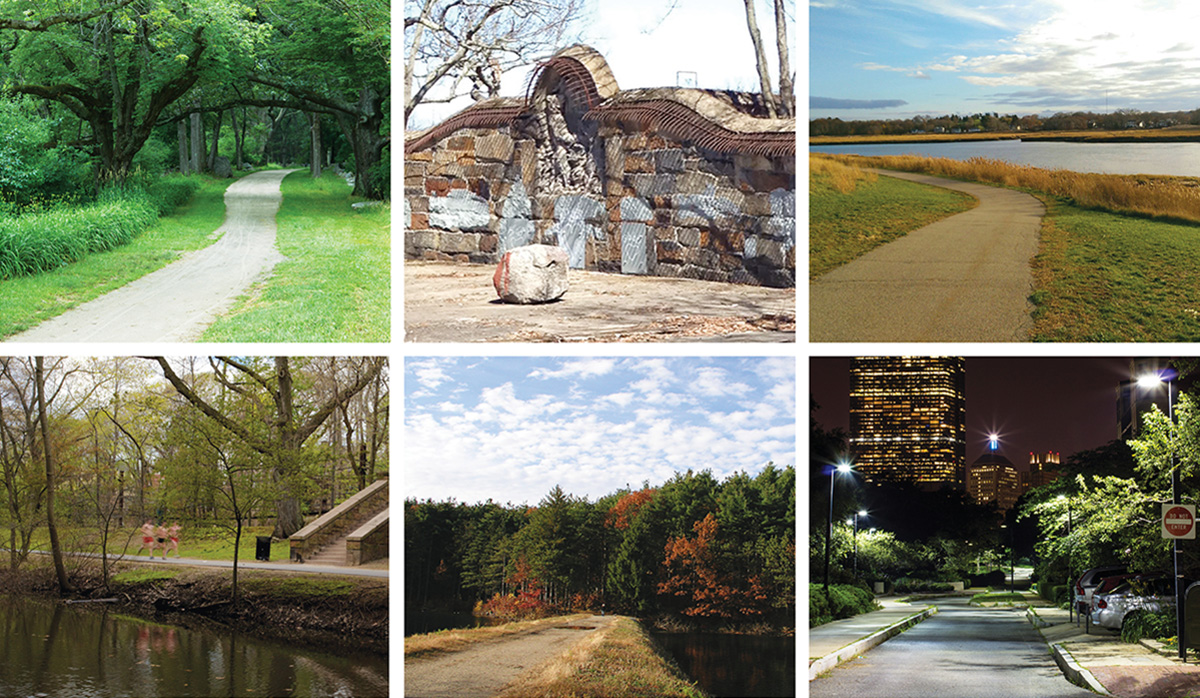
Courtesy Photos
And we’re not just talking about the Esplanade and the Chestnut Hill Reservoir. The city (and the ’burbs, for that matter) are brimming with hidden-gem routes just waiting to take you the extra mile.
- Battle Road Trail | Lexington, Concord | Soldiers marched this road en route to the battle of April 19, 1775, credited with launching the American Revolution. Today, you can use the 5-mile path to run from Lexington to Concord, stopping at historic sites and scenic overlooks.
- Long Crouch Woods Trail | Roxbury | If you follow the trail within Franklin Park’s 26-acre Long Crouch Woods, you can catch a glimpse of an abandoned bear habitat, dating to 1912, that was located in a now-defunct part of the Franklin Park Zoo.
- Lower Neponset River Trail | Dorchester, Milton | Meander your way from Dorchester to Milton on this little-known route, tracing the path of an old railroad bed that once ran alongside the Neponset. A brief 2.4 miles, the trail features an array of flora and fauna.
- Muddy River Path | Boston, Brookline | Starting at the north bank of the Muddy River, near Boston’s Park Drive, this roughly 3-mile path weaves its way from the Fenway to the heart of Brookline, offering a peaceful alternative to an urban run.
- Reservoir Trail | Melrose | You already hike the Middlesex Fells. Why not run it, too? Reservoir Trail, a 5.2-mile journey within the reservation, guides you past the grounds’ north, middle, and south reservoirs, offering idyllic water views.
- Southwest Corridor Park | Boston, Roxbury, Jamaica Plain | Give Orange Line commuters a wave as you race from the Back Bay to Forest Hills on this 4.7-mile strip of urban park parallel to the MBTA’s tracks. For extra credit, continue on to the Arnold Arboretum when you arrive at Forest Hills.
Because
7. We Have the Oldest (and Best) Marathon
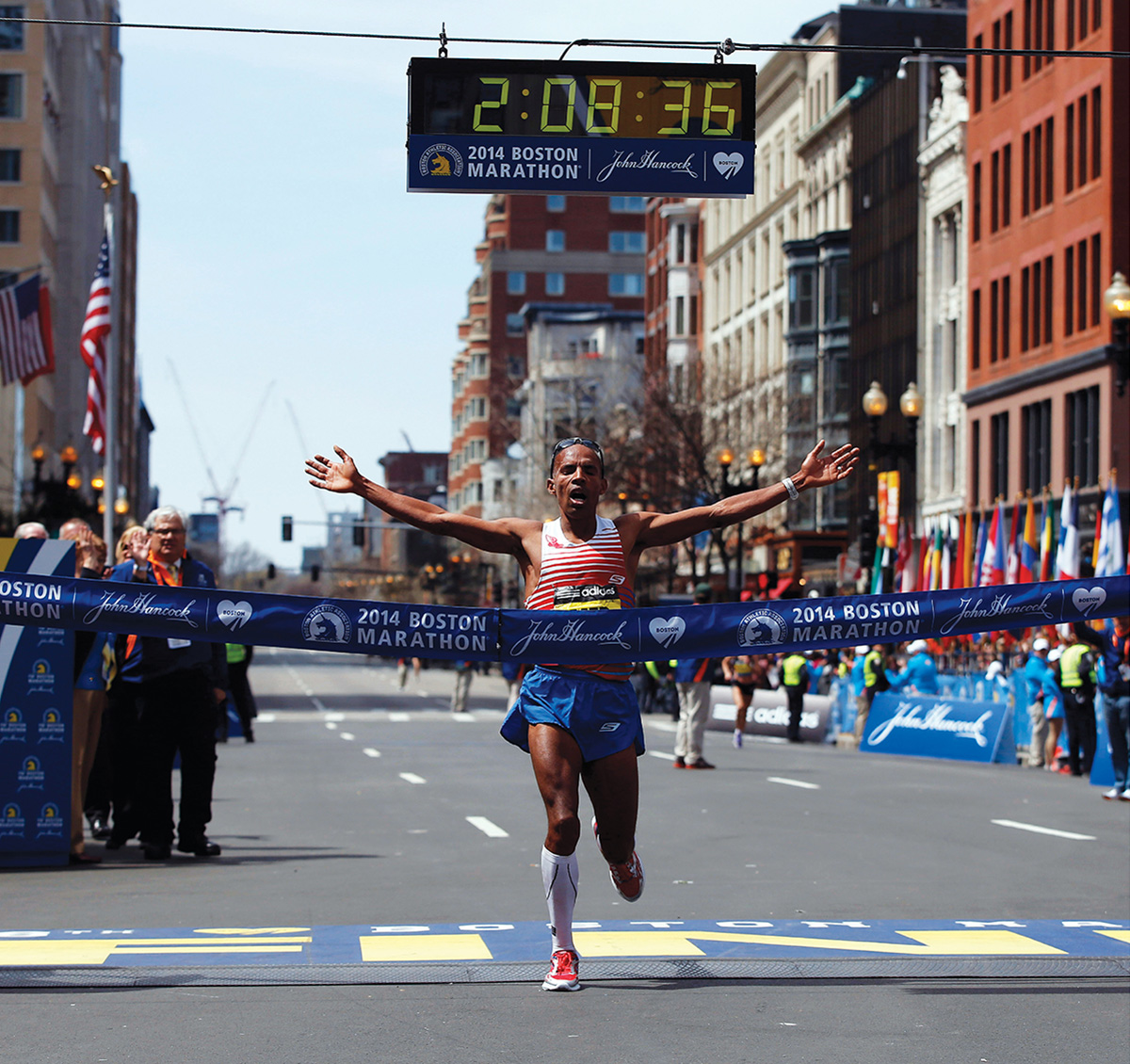
Photograph by Elise Amendola/AP Images
On April 21, 2014, an Eritrean-born American named Meb Keflezighi charged down Boylston and became the 118th men’s winner of the Boston Marathon.
It was a momentous day for Keflezighi, who, the instant he crossed the finish line, became the first American to win running’s Triple Crown: an Olympic medal, the New York City Marathon, and the Boston Marathon. But for a city still grieving from the tragedy of a year before, watching an American wear that ivy crown for the first time since 1983 may have meant even more.
Keflezighi, 41, plans to retire after this year’s New York City Marathon, finishing his career after a symbolic 26 marathons. Before he lines up in Hopkinton one last time this spring, we asked Keflezighi about his historic Boston victory, his impending retirement, and why New Englanders are so tough.
Do you have a philosophy that guides your training?
I always say run to win. Get the best out of yourself, not only on race day, but every day. Put in the work, and visualize that good things will happen.
You’re running your final Boston Marathon this year. How does it compare to other courses?
It’s definitely one of the hardest ones, if not the hardest. You have to think ahead and have something reserved for those Newton hills. Even the slightly downhill is not a pleasant downhill because your body’s beat up at that point.
None of it seems pleasant.
That’s why I’m retiring! [Laughs.]
What’s your least favorite thing about running?
The cold weather. I’m not a cold person. I live in San Diego; I don’t have to complain. Running in the bad weather—I’m not a big fan.
It’s good you don’t train in Boston, then.
They say that New Englanders are tougher because they train in tough conditions. On race day it is what it is, but I wouldn’t want to train there year round. Much respect to them, though.
Which was better: winning Olympic silver in 2004, or winning the Boston Marathon in 2014?
The Boston Marathon. It was more meaningful for me. I already had won New York in 2009 and an Olympic medal in 2004. Boston was the thing that was missing. There was something higher—I believe in God—that put it all together for me that day, two weeks shy of my 39th birthday.
Did the victory carry more weight coming a year after the marathon bombings?
The slogan “Boston Strong” carried me through day-to-day training. I just wanted to do something really positive on Boylston Street. To be able to be in the lead, in front of 36,000 people, and hear the crowd chant “USA, USA”…it’s hard to put it into words. The Bostonians never said congratulations, really—they just said thank you. To have them say thank you means a lot to me. For the Bostonians, after what they went through, hopefully it’s just a small gesture of expediting the healing process.
We have to ask: Did you ever consider ending your career in Boston?
After I won, I said, “This would be a great way to leave the sport.” But then you just want to be able to enjoy it for a few more years, try to make another Olympic team. It made sense to finish in New York, just because that was the first opportunity I had to do a marathon. I just didn’t know there would be 25 other ones in between!
Think you have one more victory in you?
Can it be? Never say never. I guess we’ll wait and see what happens on April 17.
Because
8. We Run Inside AND Out
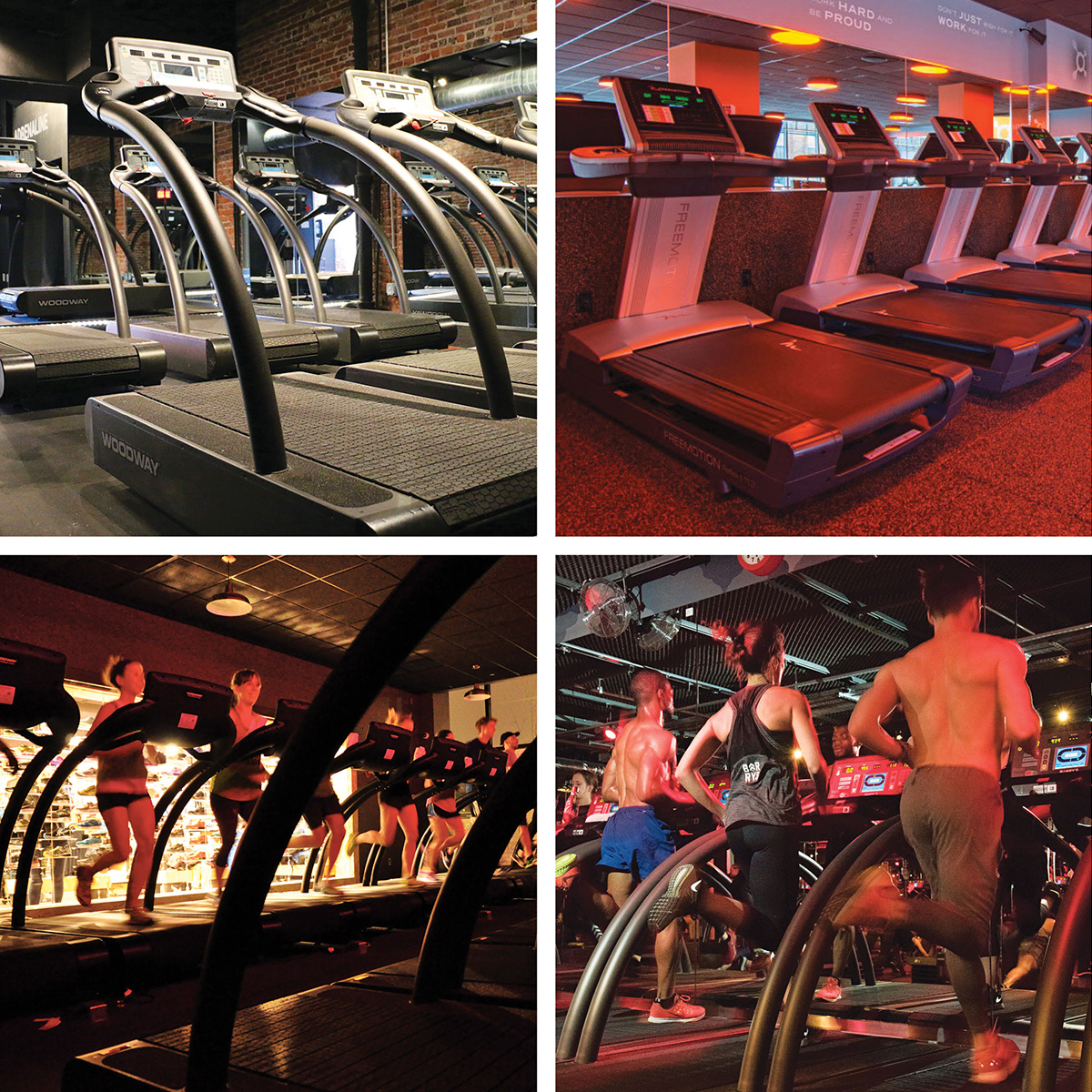
Courtesy Photos
Real athletes don’t take an off-season. Thanks to these four indoor havens, Boston’s fittest can keep their hearts pumping 365 days a year.
- My Stryde | The hard-core classes at Boston’s first treadmill-only studio are taught on high-end Woodway machines, which are easier on the joints and can be switched into manual mode—you power the belt yourself—for that extra push. $29 per class; 456 Hanover St., Boston, 857-284-7763, mystryde.com.
- Orangetheory Fitness | Orangetheory’s hourlong boot camps are a blessing for those who can’t stomach a full hour on the treadmill. Each session mixes running with strength-training drills and indoor rowing for a jam-packed, always-changing workout. $30 per class; 10 Saint James Ave., Boston, 617-936-4890; and other locations; orangetheoryfitness.com.
- Heartbreak Hill Running Company | Treadmill classes at Heartbreak Hill’s new Cambridge studio, all of which are taught by dedicated athletes, include distance runs, speed sessions, and circuit training. Pick your poison. $30 per class; 294 Massachusetts Ave., Cambridge, 617-945-7137, heartbreakhillrunningcompany.com.
- Barry’s Bootcamp | Each Barry’s session alternates between punishing treadmill drills—think all-out sprints and inhuman inclines—and strength-training exercises on the floor. You’ll leave exhausted, guaranteed. $30 per class; 30 Chauncy St., Boston, 857-350-4019, barrysbootcamp.com.
Because
9. Our Community Is Second to None
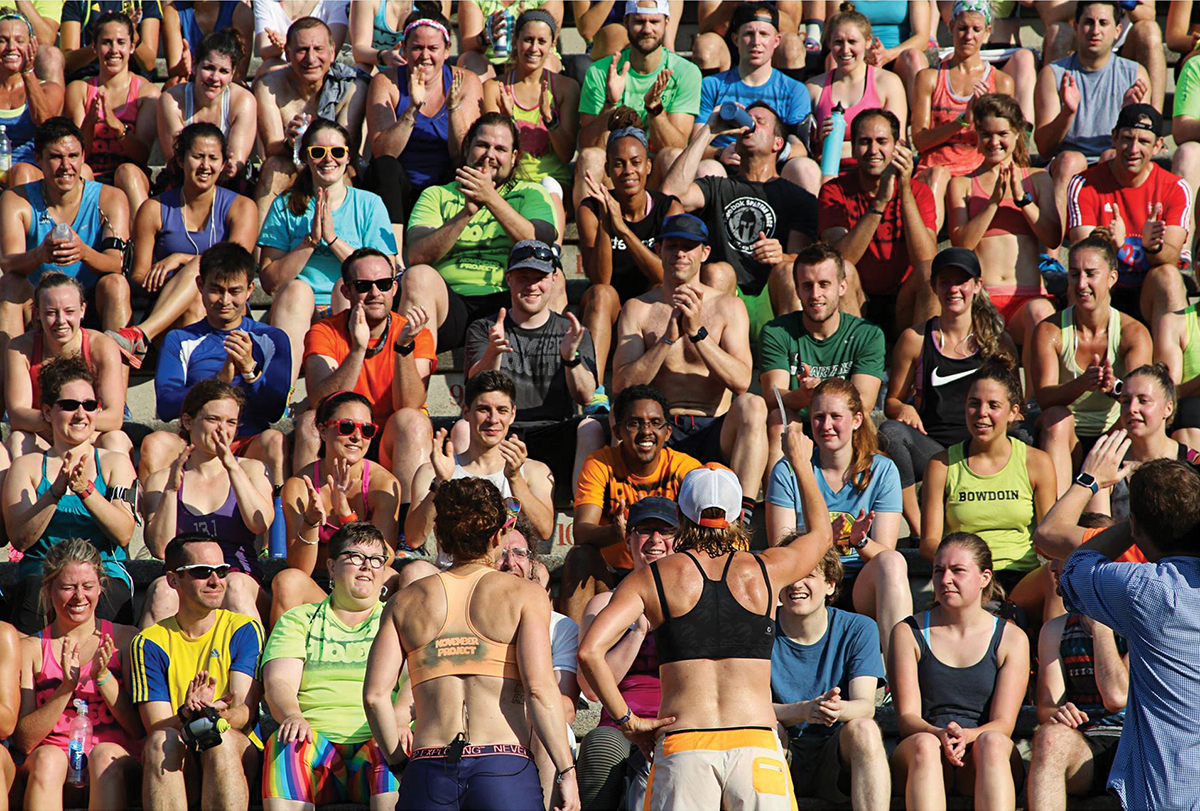
Photograph by Chris Capozzi
Sure, every city has run clubs. But here in Boston, we go way beyond vanilla jogging meetups. From Liberty Athletic Club, the nation’s oldest women’s running group, to boozy pub runs at area breweries, our community is as diverse as it is vibrant. Below, a club for every reason you run.
- For expert guidance | The Heartbreakers: Named USA Track & Field New England’s running club of the year, the Heartbreakers are the official club of Heartbreak Hill Running Company, a gear emporium owned by coach Dan Fitzgerald. For $150, you’ll get group instruction from professional runners in Newton, Cambridge, and the South End.
- For hundreds of new friends | November Project: If gathering to hug, chant, and suffer through hard-core workouts at 6:30 in the morning sounds appealing, you may be ready to join the cult of November Project (pictured), which meets at various locations no matter the weather.
- For fitness with a side of culture | Janji Nomadic Run Crew: This new group gathers at running store Janji’s pop-up on Newbury Street every Saturday morning for a 10-mile outing, purposely passing interesting street art along the way.
- For casual jogs | The Most Informal Running Club Ever: Come for the low-key 4-, 6-, or 7-mile loops on Saturday mornings, stay for the potluck-style breakfast afterward. The group meets at Eastern Mountain Sports on Commonwealth Avenue.
Because
10. We Look Good While Doing It
Let New York and Paris rule the catwalks. Here in Boston, we hit our style stride when we’re, well, in stride. From the city’s boutique gyms to its ever-populated running paths, our athleisure game is on point, as evidenced in this quintessential runner’s getup.
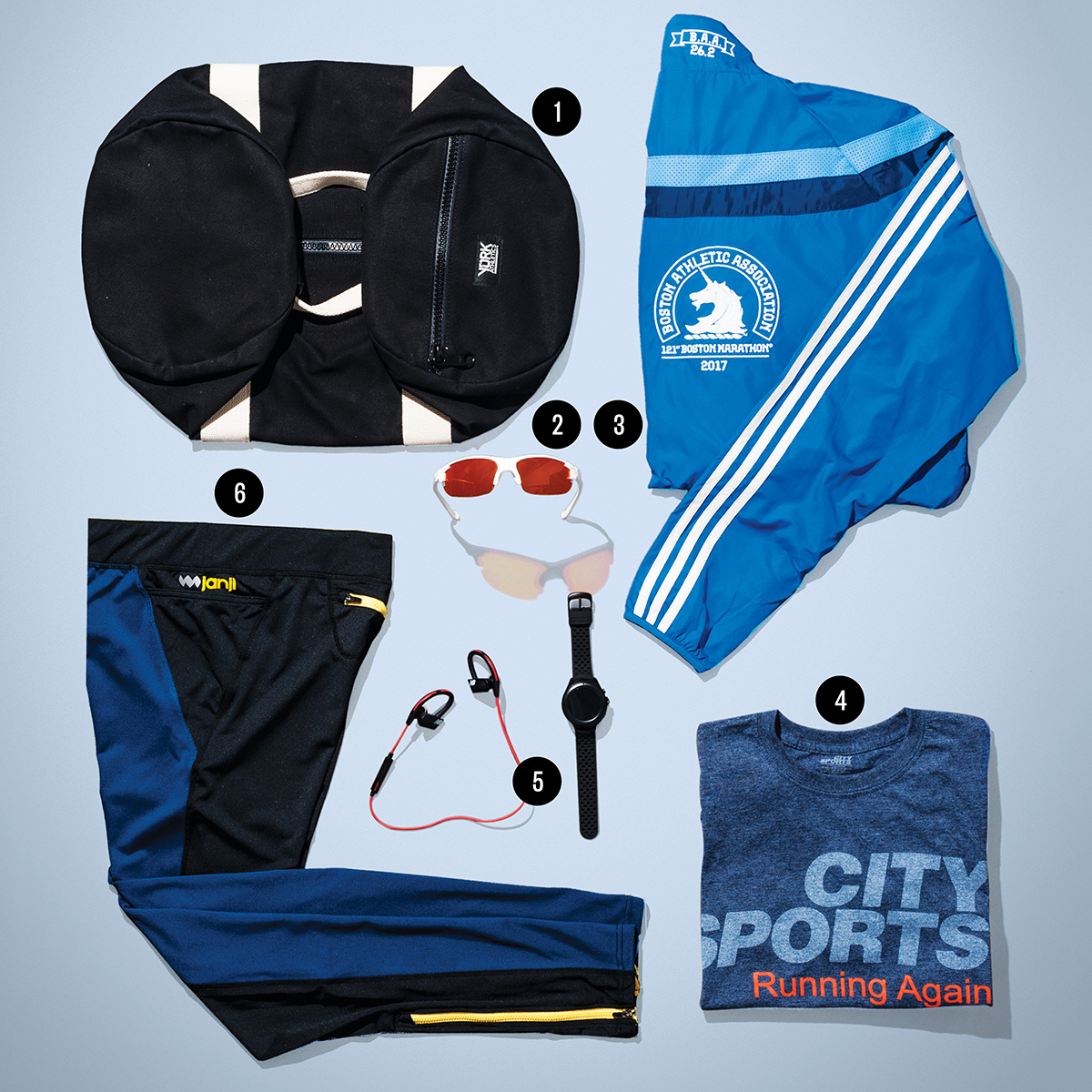
Photograph by Toan Trinh, Styling by Abby Bielagus
- When your runs take you to every corner of the city, you need a bag that can travel—bonus points for one that’s designed locally. York Athletics Mfg. duffel bag, $118, yorkathleticsmfg.com.
- Sunnies are a must for early evenings on the Esplanade—and in this startup hub, even better if they’re 3-D-printed and custom-fit. Skelmet “Falcon” sunglasses, $229, skelmet.com.
- Because you either ran the world’s best marathon, or want to look like you did. Adidas Boston Marathon “Celebration” jacket, $110, marathonsports.com.
- City Sports is still alive and well in our hearts—and in our wardrobes. City Sports “Running Again” T-shirt, $20, citysports.com.
- A brisk morning jog in this notoriously competitive city isn’t complete without a watch that tracks splits, mileage, and heart rate—don’t forget the matching earbuds. New Balance “RunIQ” watch, $300, and “PaceIQ” wireless earbuds, $110, newbalance.com.
- Look stylishly understated in neutral running tights. This is still Boston, after all. Janji “Taji” tights, $74, runjanji.com.
Additional reporting by Hallie Smith


